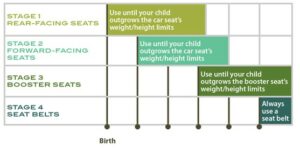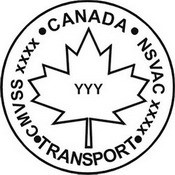Shopping around for a carseat for your newborn can be very overwhelming. There are so many regulations, differing from each province and state. The only way to know all of the recommendations for newborn carseats, is doing your research and keeping up-to-date with current
information.
Choosing the right car scat and correctly following its instructions could directly affect your baby in the unfortunate event of a car accident. Are you making the right choice for your baby? What are you supposed to know?
Based on the car seat standards updated by the Government of Canada in 2011, the following are 5 facts you may not have known before starting to shop around for your car seat.
1. Car Seat Stages: Car seats have different stages based on age and weight of the child. It is important to select the appropriate car seat stage for your child. It is safest to keep your child in each stage the longest as possible. Each car seat will have different instructions, stages, and weight and height requirements. Therefore it is important to follow the recommendations from the car seat brand and company.

2. Hear facing car seats: Hear Facing Car seats are the first stage which starts as newborn. These seats have specific instructions for each manufacturer, but generally are all placed at a 4: degree angle to allow the baby to breathe easier, and have head supports and snug fitting harnesses to support the baby in the unfortunate case of a car accident.
3. Expiry: All car seats have an expiry date. It is important to verify this date and if close to the expiry date to purchase a new car seat. If the car seat is damaged, torn, or broken in any way or has been involved in a car accident, a new car seat must be purchased.
4- Recalls: Recalls on manufactured car seats can be verified on the Canada Transport website. The only way to receive notifications about safety recalls about the product is to register the car seat with the manufacturer after purchasing.
5. National Safety Mark: The National Safety Mark (sample shown below) indicates that a child car seat is certified to Canadian sa1’ety standards, which are different from other standards. It is illegal to import, sell, or use child car scats and booster scats in Canada that do not have this mark. It is advised to only purchase car seats in Canada in order to be sure they meet the Canadian safety standards.

6. Car seat checks: Yes! There are institutions in your area that can verify that a car seat is properly set up in your car. They can help you with the setup, teach you how to do it in the future, and make sure that your car seat meets the Transport Canada standards. Look up “check car seats” near you, many public safety municipal institutions, CAA’s, and Canadian Tires verify child car seats. There is also a video on the SAAQ website that explains how to install the car seat and how to select the correct car seat for your infant’s age, weight, and height.
www.childcarseat.qc.ca
Just a reminder: there is no “one size”, each car seat has different instructions and stages for children. It is up to the parent or guardian to make sure these recommendations fit the Transport Canada regulations. Stay informed, register your car seat with the manufacturer to receive updates on recalls, and verify the expiry date.